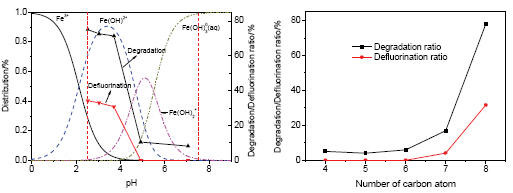| [1] Rayne, S.; Forest, K.J.Environ.Sci.Heal.C 2009, 44, 1145.[2] Holzer, J.; Midasch, O.; Rauchfuss, K.; Kraft, M.; Reupert, R.; Angerer, J.; Kleeschulte, P.P.; Marschall, N.; Wilhelm, M.Environ.Health Persp.2008, 116, 651.[3] Lynda, A.N.; John, M.N.; Frances, S.S.; Nancy, V.R.; Edward, A.E.Reprod.Toxicol.2009, 27, 231.[4] Lindstrom, A.B.; Strynar, M.J.; Libelo, E.L.Environ.Sci.Technol.2011, 45, 7954.[5] Schroder, H.F.; Meesters, R.J.W.J.Chromatogr.A 2005, 1082, 110.[6] Dillert, R.; Bahnemann, D.; Hidaka, H.Chemosphere 2007, 67, 785.[7] Song, C.; Chen, P.; Wang, C.; Zhu, L.Chemosphere 2012, 86, 853.[8] Park, H.; Vecitis, C.D.; Cheng, J.; Choi, W.; Mader, B.T.; Hoffmann, M.R.J.Phys.Chem.A 2009, 113, 690.[9] Yamamoto, T.; Noma, Y.; Sakai, S.; Shibata, Y.Environ.Sci.Technol.2007, 41, 5660.[10] Wang, Y.; Zhang, P.Y.; Pan, G.; Chen, H.J.Hazard.Mater.2008, 160, 181.[11] Wang, Y.; Zhang, P.Y.J.Hazard.Mater.2011, 192, 1869.[12] Wang, Y.; Zhang, P.Y.Acta Chim.Sinica 2010, 68, 345.(王媛, 张彭义, 化学学报, 2010, 68, 345).[13] Dillert, R.; Bahnemann, D.; Hidaka, H.Chemosphere 2007, 67, 785.[14] Panchangam, S.C.; Lin, A.Y.C.; Shaik, K.L.; Lin, C.F.Chemosphere 2009, 77, 242.[15] Lee, Y.C.; Lo, S.I.; Kuo, J.; Hsieh, C.H.Front.Environ.Sci.Eng.2012, 6, 17.[16] Deng, N.S.; Wu, F.Environmental Photochemistry, Chemical Industry Press, Beijing, 2003, pp.83~101.(邓南圣, 吴锋, 环境光化学, 化学工业出版社, 北京, 2003, pp.83~101).[17] Martin, J.W.; Mabury, S.A.; Solomon, K.R.; Muir, D.C.G.Environ.Toxicol.Chem.2003, 22, 189.[18] Rebecca, R.Environ.Sci.Technol.2006, 40, 12.[19] Sun, H.W.; Li, F.S.; Zhang, T.; Zhang, X.Z.; He, N.; Song, Q.; Zhao, L.J.; Sun, L.N.; Sun, T.H.Water Res.2011, 45, 4483.[20] Quinete, N.; Wu, Q.; Zhang, T.; Yun, S.H.; Moreira, I.; Kannan, K.Chemosphere 2009, 77, 863.[21] Naile, J.E.; Khim, J.S.; Wang, T.Y.; Chen, C.L.; Luo, W.; Kwon, B.; Park, J.; Koh, C.H.; Jones, P.D.; Lu, Y.L.; Giesy, J.P.Environ.Pollut.2010, 158, 1237.[22] Mak, Y.L.; Taniyasu, S.; Yeung, L.W.Y.; Lu, G.H.; Jin, L.; Yang, Y.L.; Lam, P.K.S.; Kannan, K.; Yamashita, N.Environ.Sci.Technol.2009, 43, 4824.[23] Stefannson, A.Environ.Sci.Technol.2007, 41, 6117.[24] Dean, J.A.Lange’s Handbook of Chemistry, 15th ed., McGraw-Hill Inc., New York, 1999, p.1195.[25] Vecitis, C.D.; Park, H.; Cheng, J.; Mader, B.T.; Hoffmann, M.R.Front.Environ.Sci.Eng.2009, 3, 129.[26] Niu, J.F.; Lin, H.; Gong, C.; Sun, X.M.Environ.Sci.Technol.2013, 47, 14341.[27] Niu, J.F.; Lin, H.; Gong, C.; Sun, X.M.Environ.Sci.Technol.2012, 46, 10191.[28] Zhuo, Q.F.; Deng, S.B.; Yang, B.; Huang, J.; Wang, B.; Zhang, T.T.; Yu, G.Electrochim.Acta 2012, 77, 17.[29] Taniyasu, S.; Yamashita, N.; Yamazaki, E.; Petrick, G.; Kannan, K.Chemosphere 2013, 90, 1686.[30] Hori, H.; Yamamoto, A.; Koike, K.; Kutsuna, S.; Osaka, I.; Arakawa, R.Chemosphere 2007, 68, 572. |
